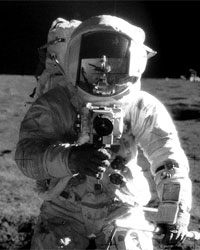Apollo 11,12 and 14 to 17 successfully landed in different areas of the moon, and evidence of our visits was left at each landing site. Parts of six lunar landing units, three electric lunar vehicles and an array of scientific instruments are on the moon
18.7.2004
By: Anna Heiney, NASA

By the end of NASA's Apollo program in December 1972, six crews of astronauts, six Apollo command units and more than 800 pounds (about 363 kg) of rocks and soil from the moon had been brought to Earth. However, some things were left behind on purpose.
Apollo 11,12 and 14 to 17 successfully landed in different areas of the moon, and evidence of our visits was left at each landing site. Parts of six lunar landing units, three electric lunar vehicles and an array of scientific instruments are on the moon.
Weight limitations forced us to leave so much material on the moon. "The more we threw, the more rocks we were able to bring to Earth," explained Stan Starr, deputy project manager and chief engineer at Dynamac at NASA's Kennedy Space Center in Florida.
The lower part of the lunar landers (the part through which you go down to the ground) allowed the crew to land on the moon and served as a launch pad when the crews left the moon. An American flag was placed at each landing site, and plaques were attached to the legs of the parts of the lander that were left behind. The plaques carry the message that humans from Earth visited the moon with peaceful intentions.
The scientific aspect of the Apollo missions was mainly devoted to lunar geology. Seismometers, instruments that detect and measure lunar earthquakes and meteor impacts, were left on the moon by the entire Apollo crew. Once the lander parts needed for ascent were used up, they were thrown towards the lunar soil in order to give scientists a controlled seismic event. Other scientific instruments have measured changes in lunar gravity and subsurface temperatures. A wide range of geological tools, such as long-handled rakes, tubes for collecting soil cores and other tools were also left on the moon.
The lunar crews also left behind most of their cameras, through which they shared their experience with millions of people on Earth, and returned home with only the film in their hands. Apollo 16 even left behind a gold-plated ultraviolet telescope, which made the first astronomical observations from a celestial body other than Earth.
Apollo 11, 14 and 15 left behind retroreflectors for measuring range, which are still functional after three decades. The arrays of these instruments provide us with information about the distance to the moon and the fact that the distance increases over time. The reflectors are so tiny that pointing lasers at them from Earth is equivalent to using a rifle to hit a coin, moving two miles away.
The astronauts also got to have some fun. Alan Shepard, Apollo 14 commander, hit three golf balls, which are still resting in the Pera Mauro region of the moon. His first two putts fell short, but the third sent the ball traveling "miles upon miles," Shepherd reported.
The United States' national vision for space exploration calls for NASA to return to the Moon and use it as a springboard to Mars and beyond. Will it be possible to use the materials left on the moon from the Apollo missions for new missions?
"In principle, astronauts will be able to replace the batteries in the electric vehicles and reuse them, if their gearboxes and other moving parts in them are not filled with dust," Starr said. “They might be able to charge the oxygen and carbon dioxide purification devices that are in the Apollo pods, or maybe try to use the helmets and gloves that are there. However, after all this time on the surface, dust surely fills every corner. Further use of this equipment will require careful testing and planning, as it was not designed to withstand repeated use.”
Meanwhile, the equipment and materials, which we left there, will be left exactly where we left them, waiting in dusty silence for our return.
Translation: Dikla Oren
The editor of the website adds: In one of the news stories that originated on the Ynet website and which were published on YNET, one of the surfers responded as if the whole story of the moon landing was fake and it was created in Hollywood studios. Here is a great opportunity to check it out. The next spacecraft that land will have plenty of equipment that can be photographed and even taken back home, unless it is decided that the next landing will also be fabricated.
